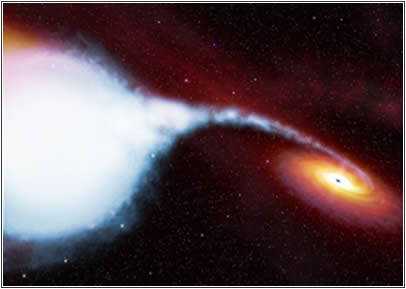
You are here: Home >> History of Light >> General Relativity >> Black holes
We saw that finally the gravity pulls light, just like a rock. A rock can follow circular orbits around e.g. a planet. Could this happen to light too? Yes! A very heavy object with a very small radius could do this. It should be an object as heavy as the Sun with a radius smaller than 3 km.
 We can also think about something so compact and dense, that would not let light escape and to be perfect black. This is a black hole, an extremely dense celestial body that has been theorized to exist in the universe.
We can also think about something so compact and dense, that would not let light escape and to be perfect black. This is a black hole, an extremely dense celestial body that has been theorized to exist in the universe.
The gravitational field of a black hole is so strong that, if the body is large enough, nothing, including electromagnetic radiation, can escape from its vicinity. The body is surrounded by a spherical boundary, called a horizon, through which light can enter but not escape; it therefore appears totally black.
The black-hole concept was developed by the German astronomer Karl Schwarzschild in 1916 on the basis of German American physicist Albert Einstein's general theory of relativity. The radius of the horizon of a Schwarzschild black hole depends only on the mass of the body, being 2.95 km times the mass of the body in solar units (the mass of the body divided by the mass of the sun).
According to general relativity, gravitation severely modifies space and time near a black hole. As the horizon is approached from outside, time slows down relative to that of distant observers, stopping completely on the horizon. Once a body has contracted within its Schwarzschild radius, it would theoretically collapse to a singularity - that is, a dimensionless object of infinite density.
Black holes remain hypothetical, but observations suggest that such phenomena may possibly exist in the star system Cygnus X-1 and at the centre of the Galaxy.
Related links (external pages)